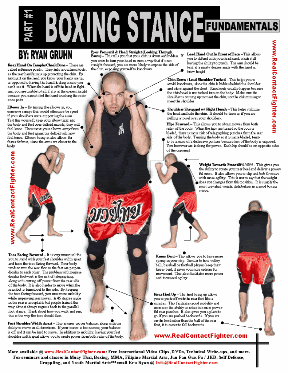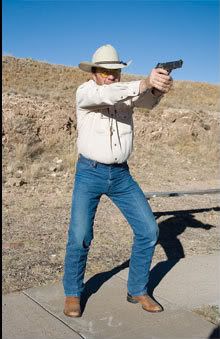In action shooting sports, the most fundamental aspect of shooting is not the gun, the grip, or reloading – the first aspect of high-speed competitive shooting is the stance. The vast majority of modern practical shooters all use the “modified isosceles stance”, which is best illustrated with the below images:

In image 1, professional MMA fighter Ryan Gruhn demonstrates the fundamental “boxing stance”. Note that the fighter is squared up towards the target, with the weak side leg (for a right handed shooter) advanced and the strong side to the rear. From this position, Ryan can advance, retreat, and deliver punches and knee strikes with power and precision.

In image 2, Jim Wilson is demonstrating the “combat” or “modern” isosceles stance. Note the similarity to the MMA fighter’s stance – the shooter’s hips are square to the target, the weak side foot is advanced, the knees are bent – all of these are combined to give the shooter the ability to deliver fast, accurate shots, while maintaining the ability to be mobile in a hurry.
The key aspects of the modern isosceles stance are the soft knees, and the extension of the arms. The knee and foot position allow the shooter to get mobile quickly, and that speed (which will be covered in a later post) is essential to practical shooting.
When shooting in a modern isosceles, the key muscles areas that end up under stress are the quadriceps, hamstring, and if you’re like me, your calf muscles. My calves get a little more stressed because I tend to shoot almost from the balls of my feet, which results in a little bit more stress placed on the calf muscles.
The issue with the isosceles is that coming in and out the stance throughout a long match can cause fatigue on the quads and hamstrings. The best way to train for that is to do one of my all time favorite exercises, the basic lunge. To train up your endurance and strength with this exercise, make sure you do it at least three times a week. The first day, do 5 or 10 repetitions per side – making sure that you switch your leading leg and repeat the reps on the other side. Then on the second day, add another 2-5 reps to each side, gradually increasing your number of reps with each workout.
The key to increasing your strength and endurance in your stance will help you provide a stable shooting platform – if your shooting stance is stable, it will allow you to deliver your shots with more accuracy and precision. There are plenty of additional exercises which will add to your stability and strength in your “fighting stance”, however for the basics right now, the lunge is enough. Remember to concentrate on your form – doing a lot of reps with sloppy form is a good way to hurt yourself. It’s better for you and your body to do fewer repetitions with proper form.
For Friday, we’re going to take a look at some additional exercises that will help with your stance, including core strength exercises and upper body work to aid in holding a 3 pound gun at arm’s length for the duration of a pistol match.